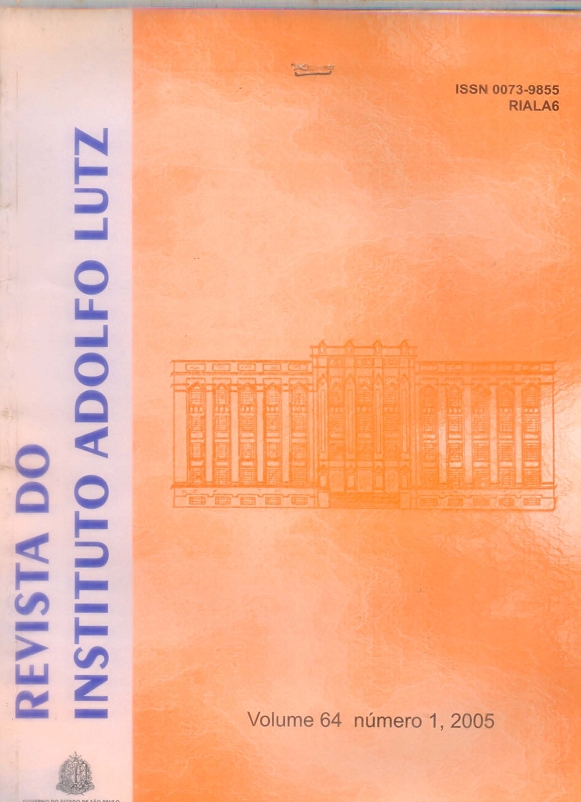Resumen
As areias de áreas de lazer podem representar um importante ecótopo para a transmissão de várias zoonoses parasitárias, dentre elas a Larva Migrans Cutânea (LMC), causada pela penetração na pele humana das larvas de ancilostomídeos de cães e gatos. Neste estudo investigou-se a contaminação dos tanques de areia por ovos e/ou larvas de Ancylostoma sp. das áreas de recreação infantil existentes em 11 praças públicas do município de Ribeirão Preto. Entre maio a dezembro de 2003, foram coletadas cinco amostras de areia de cada área de recreação. A recuperação das larvas foi realizada pelo método de Baermann, enquanto que para a detecção dos ovos utilizou-se a técnica da centrífugo-flutuação com soluções saturadas de sulfato de magnésio contendo 5% de iodeto de potássio (d = 1,33 g/cm3 ) e de sulfato de zinco (d = 1,20 g/cm3 ), após um lavado prévio com Tween 80. A presença de larvas foi observada em seis (54%) áreas de recreação, sendo que em quatro (36%) delas foram encontrados ovos de Ancylostoma sp. Estes resultados indicam um risco para a ocorrência da LMC nos usuários destas áreas.Citas
1. Centers for Disease Control and Prevention. Division of Parasitic Diseases. Guidelines for Veterinarians - Prevention of zoonotic transmission of ascarids and hookworms of dogs and cats. Available from: http://www.cdc.gov/ncidod/diseases/roundworm.htm
2. Schaub NA, Perruchoud AP, Buechner SA. Cutaneous larva migrans associated with Löeffler’ syndrome. Dermatology 2002; 205(2):207-9.
3. Croese J, Loukas A, Opdebeeck J, Fairley S, Prociv P. Human enteric infection with canine hookworms. Ann Intern Med 1994; 120(5):369-74.
4. Alcântara N, Bavia E, Silvão RM, Carvalho E. Environmental contamination by Toxocara sp eggs in public areas of Salvador, Bahia State, Brazil. Rev Soc Bras Med Trop 1989; 22(4):187-90.
5. Chieffi PP, Müller EE. Prevalência de parasitismo por Toxocara canis em cães e presença de ovos de Toxocara sp no solo de localidades públicas da zona urbana do município de Londrina, Estado do Paraná, Brasil. Rev Saúde Pub, 1976; 10:367-72.
6. Araújo FR, Araújo CP, Werneck MR, Górski A. Larva migrans cutâneaem crianças de uma escola em área do centro-oeste do Brasil. Rev Saúde Pub, 2000; 34(1): 84-5.
7. Lima WS, Camargo MCV, Guimarães MP. Surto de larva migrans cutânea em uma creche de Belo Horizonte, Minas Gerais (Brasil). RevInst Med Trop 1984; 26(2): 122-4.
8. Nunes CM, Pena FC, Negrelli GB, Anjo CGS, Nakano MM, Stobbe NS. Ocorrência de larva migrans na areia de áreas de lazer das escolas municipais de ensino infantil, Araçatuba, SP, Brasil. Rev Saúde Pub, 2000; 34(6): 656-8.
9. Santarém VA, Giuffrida R, Zanin GA. Larva migrans cutânea: ocorrência de casos humanos e identificação de larvas de Ancylostoma spp em parque público do município de Taciba, São Paulo. Rev Soc Bras Med Trop 2004m 37(2): 179-81.
10. Pessôa SB, Martins AV. Pessôa Parasitologia Médica. 10a ed. Rio deJaneiro: Ed Guanabara Koogan; 1977.

Esta obra está bajo una licencia internacional Creative Commons Atribución 4.0.
Derechos de autor 2005 Revista del Instituto Adolfo Lutz
